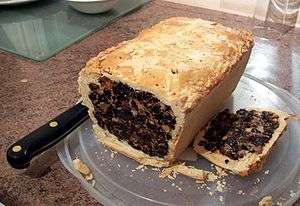Black bun
|
A black bun cut open, showing fruit cake interior | |
| Alternative names | Scotch bun, Scotch Christmas bun |
|---|---|
| Type | Fruit cake |
| Place of origin | Scotland |
| Main ingredients | pastry, raisins, currants, almonds, citrus peel, allspice, ginger, cinnamon and pepper |
|
| |
Black bun is a type of fruit cake completely covered with pastry. It is Scottish in origin, originally eaten on Twelfth Night but now enjoyed at Hogmanay. The cake mixture typically contains raisins, currants, almonds, citrus peel, allspice, ginger, cinnamon and black pepper. It had originally been introduced following the return of Mary, Queen of Scots from France, but its original use at Twelfth Night ended with the Scottish Reformation. It was subsequently used for first-footing over Hogmanay.
Description
Black bun is a fruit cake wrapped in pastry. The cake itself is similar to a traditional Christmas cake or Christmas pudding mixture, including ingredients such as raisins and currants along with spices such as cinnamon, black pepper and allspice.[1][2] It has been called a much bigger version of a Garibaldi biscuit, and it has been suggested that the origin of that biscuit may have been influenced by the black bun because the inventor of the biscuit, John Carr, was Scottish.[3]
Outside Scotland, the black bun is also eaten in the Appalachia region of the United States.[4] In 2013, a recipe was demonstrated by Paul Hollywood on a Christmas special of The Great British Bake Off.[5]
Origins
The cake was originated as a Scottish King cake for use on Twelfth Night on 5 January – the eve of Epiphany, and the end of the Twelve Days of Christmas.[6] It was introduced following the return of Mary, Queen of Scots from France, and the tradition was that a bean was hidden in the cake – whoever found it became the King for the evening. It has been recorded that Mary herself participated in such games, and in 1563 she dressed her childhood companion Mary Fleming in royal robes and jewellery after Fleming became Queen for the evening. This shocked the English Ambassador, who wrote "The Queen of the Bean was that day in a gown of cloth of silver, her head, her neck, her shoulders, the rest of her whole body, so beset with stones, that more in our whole jewel house was not to be found."[7] Following the Scottish Reformation in 1560, the celebration of Christmas was outlawed in Scotland and the use of a King cake at that time ended.[7]
The black bun type of cake in its modern usage dates from the early nineteenth century, previously called Scotch bun and Scotch Christmas bun. The term "black bun" was first recorded in 1898, and may have been a result of Robert Louis Stevenson referring to the cake as "a black substance inimical to life".[8]
The cake is now commonly used as a Hogmanay custom, where people visit their neighbours after midnight to celebrate the New Year. This was called first-foot, and the gift of a black bun was meant to symbolise that the receiving family would not go hungry during the forthcoming year.[2] It was also used a traditional cake to serve to those visiting homes as part of Hogmanay, to be consumed with whisky.[9]
See also
- List of pies, tarts and flans
 Food portal
Food portal Scotland portal
Scotland portal
References
- ↑ Hollywood, Paul. "Black bun". BBC Food. Retrieved 21 December 2013.
- 1 2 "Scottish black bun recipe". Delicious. Retrieved 21 December 2013.
- ↑ McGinn, Clark (2008). The Ultimate Guide To Being Scottish. Edinburgh: Luath. p. 44. ISBN 9781906307813.
- ↑ Sohn, Mark F. (2005). Appalachian Home Cooking. Lexington, Ky.: University Press of Kentucky. ISBN 9780813191539.
- ↑ O'Donovan, Gerard (17 December 2013). "Great British Bake Off Christmas Special, BBC Two, review". The Daily Telegraph. Retrieved 21 December 2013.
- ↑ Crump, William D. (2013). The Christmas Encyclopedia. Jefferson, North Carolina: McFarland & Company, Inc. p. 211. ISBN 9780786468270.
- 1 2 Douglas, Hugh (1999). The Hogmanay Companion. Glasgow: Neil Wilson. ISBN 9781897784938.
- ↑ Ayto, John (2012). The Diner's Dictionary (2nd ed.). Oxford: Oxford University Press. p. 33. ISBN 9780199640249.
- ↑ Smith, Patricia (12 December 2013). "Hogmanay organizers promise bigger, better Scottish New Year's party". Ottawa Citizen. Retrieved 21 December 2013.

